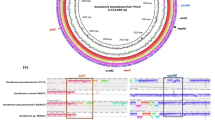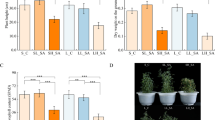Abstract
Plant endophytes play a crucial role in plant growth, health and ecological function. Jingbai pear (the best quality cultivar of Pyrus ussuriensi Maxim. ex Rupr.) has important ecological and economic value in north China. Conversation of its genetics has great meanings to pear genus (Pyrus L.). However, the bacterial community associated with the cultivar remains unknown. In this study, the structure of endophytic bacterial communities associated with different tissues and soil of Jingbai Pear trees was analyzed with Illumina Miseq sequencing of bacterial 16S rDNA. This is the first report on bacterial microbiome associated with Jingbai pear. Our results demonstrated that different tissues harbored a unique bacterial assemblage. Interestingly, Cyanobacteria was the most abundant phylum, followed by Proteobacteria and Actinobacteria. Samples from three different sites (soils) had significant differences in microbial communities structure. Redundancy analysis (RDA) showed that the bacterial community structure correlated significantly with soil properties—temperature, pH, nitrogen and carbon contents. The conclusion could facilitate to understand the interaction and ecological function of endophytic bacteria with host Jingbai pear trees, so as to benefit the pear variety genetic resource conservation and protection.






Similar content being viewed by others
References
Araújo WL, Marcon J, Maccheroni W, van Elsas JD, van Vuurde JWL, Azevedo JL (2002) Diversity of endophytic bacterial populations and their interaction with Xylella fastidiosa in citrus plants. Appl Environ Microbiol 68:4906–4914. https://doi.org/10.1128/AEM.68.10.4906-4914.2002
Azevedo JL, Maccheroni W, Pereira JA, Araújo WL (2000) Endophytic microorganisms: a review on insect control and recent advances on tropical plants. Electron J Biotechnol 3(1):15–16. https://doi.org/10.4067/S0717-34582000000100004
Berg G, Rybakova D, Grube M, Koberl M (2016) The plant microbiome explored: implications for experimental botany. J Exp Bot 67:995–1002. https://doi.org/10.1093/jxb/erv466
Bogas AC, Ferreira AJ, Araújo WL, Astolfi-Filho S et al (2015) Endophytic bacterial diversity in the phyllosphere of Amazon Paullinia cupana associated with asymptomatic and symptomatic anthracnose. SpringerPlus 4:258. https://doi.org/10.1186/s40064-015-1037-0
Bolger AM, Lohse M, Usadel B (2014) Trimmomatic: a flexible trimmer for Illumina sequence data. Bioinformatics 30:2114–2120. https://doi.org/10.1093/bioinformatics/btu170
Bremner JM (1965) Total nitrogen. In: Black CA (ed) Methods of soil analysis part 2: chemical and microbial properties. American Society of Agronomy Publisher Inc., Madison, pp 1049–1178
Campisano A, Pancher M, Puopolo G, Puddu A, Lòpez-Fernàndez S, Biagini B, Yousaf S, Pertot I (2015) Diversity in endophyte populations reveals functional and taxonomic diversity between wild and domesticated grapevines. Am J Enol Vitic 66(1):12–21. https://doi.org/10.5344/ajev.2014.14046
Carvalho TL, Ballesteros HG, Thiebaut F, Ferreira PC, Hemerly AS (2016) Nice to meet you: genetic, epigenetic and metabolic controls of plant perception of beneficial associative and endophytic diazotrophic bacteria in non-leguminous plants. Plant Mol Biol 90(6):561–574. https://doi.org/10.1007/s11103-016-0435-1
Chang S, Puryear J, Cairney J (1993) A simple and efficient method for isolating RNA from pine trees. Plant Mol Biol Rep 11:113–116. https://doi.org/10.1007/BF02670468
Chen B, Shen J, Zhang X, Pan F, Yang X, Feng Y (2014) The endophytic bacterium, Sphingomonas SaMR12, improves the potential for zinc phytoremediation by its host, Sedum alfredii. PLoS One 9:e106826. https://doi.org/10.1371/journal.pone.0106826
Clooney AG, Fouhy F, Sleator RD, O’Driscoll A, Stanton C, Cotter PD, Claesson MJ (2016) Comparing apples and oranges?: next generation sequencing and its impact on microbiome analysis. PLoS One 11:e0148028. https://doi.org/10.1371/journal.pone.0148028
Edwards J, Johnson C, Santos-Medellin C, Lurie E et al (2015) Structure, variation, and assembly of the root-associated microbiomes of rice. Proc Natl Acad Sci USA 112:E911–E920. https://doi.org/10.1073/pnas.1414592112
Enya J, Shinohara H, Yoshida S, Tsukiboshi T et al (2007) Culturable leaf-associated bacteria on tomato plants and their potential as biological control agents. Microb Ecol 53(4):524–536. https://doi.org/10.1007/s00248-006-9085-1
Fidalgo C, Henriques I, Rocha J, Tacao M, Alves A (2016) Culturable endophytic bacteria from the salt marsh plant Halimione portulacoides: phylogenetic diversity, functional characterization, and influence of metal (loid) contamination. Environ Sci Pollut Res Int 23(10):10200–10214
Fürnkranz M, Wanek W, Richter A, Abell G, Rasche F, Sessitsch A (2008) Nitrogen fixation by phyllosphere bacteria associated with higher plants and their colonizing epiphytes of a tropical lowland rainforest of Costa Rica. ISME J 2(5):561–570
Gagne-Bourgue F, Aliferis K, Seguin P, Rani M, Samson R, Jabaji S (2013) Isolation and characterization of indigenous endophytic bacteria associated with leaves of switchgrass (Panicum virgatum L.) cultivars. J Appl Microbiol 114(3):836–853. https://doi.org/10.1111/jam.12088
Gantar M, Rowell P, Kerby NW, Sutherland IW (1995) Role of extracellular polysaccharide in the colonization of wheat (Triticum vulgare L.) roots by N2-fixing cyanobacteria. Biol Fertil Soils 19(1):41–48. https://doi.org/10.1007/BF00336345
Garbeva P, Van Overbeek LS, Van Vuurde JWL, Van Elsas JD (2001) Analysis of endophytic bacterial communities of potato by plating and denaturing gradient gel electrophoresis (DGGE) of 16S rDNA based PCR fragments. Microb Ecol 41(4):369–383. https://doi.org/10.1007/s002480000096
Golinska P, Wypij M, Agarkar G, Rathod D, Dahm H, Rai M (2015) Endophytic actinobacteria of medicinal plants: diversity and bioactivity. Antonie Van Leeuwenhoek 108(2):267–289. https://doi.org/10.1007/s10482-015-0502-7
Hong YW, Liao D, Hu AY, Wang H et al (2015) Diversity of endophytic and rhizoplane bacterial communities associated with exotic Spartina alterniflora and native mangrove using Illumina amplicon sequencing. Can J Microbiol 61(10):723–733. https://doi.org/10.1139/cjm-2015-0079
Hortova B, Novotny D (2011) Endophytic fungi in branches of sour cherry trees: a preliminary study. Czech Mycol 63(1):77–82
Janisiewicz WJ, Jurick WM, Peter KA, Kurtzman CP, Buyer JS (2014) Yeasts associated with plums and their potential for controlling brown rot after harvest. Yeast 31(6):207–218. https://doi.org/10.1002/yea.3009
Khan AL, Waqas M, Kang SM, Al-Harrasi A et al (2014) Bacterial endophyte Sphingomonas sp. LK11 produces gibberellins and IAA and promotes tomato plant growth. J Microbiol 52(8):689–695. https://doi.org/10.1007/s12275-014-4002-7
Kim H, Nishiyama M, Kunito T, Senoo K et al (1998) High population of Sphingomonas species on plant surface. J Appl Microbiol 85(4):731–736. https://doi.org/10.1111/j.1365-2672.1998.00586.x
Kovalchuk A, Mukrimin M, Zeng Z, Raffaello T, Liu MX, Kasanen R, Sun H, Asiegbu FO (2018) Mycobiome analysis of asymptomatic and symptomatic Norway spruce trees naturally infected by the conifer pathogens Heterobasidion spp. Environ Microbiol Rep. https://doi.org/10.1111/1758-2229.12654
Kozich JJ, Westcott SL, Baxter NT, Highlander SK, Schloss PD (2011) Development of a dual-index sequencing strategy and curation pipeline for analyzing amplicon sequence data on the MiSeq Illumina sequencing platform. Appl Environ Microbiol 79:5112–5120. https://doi.org/10.1128/AEM.01043-13
Langille MGI, Zaneveld J, Caporaso JG, McDonald D et al (2013) Predictive functional profiling of microbial communities using 16S rRNA marker gene sequences. Nat Biotechnol 31:1–10
Liaqat F, Eltem R (2016) Identification and characterization of endophytic bacteria isolated from in vitro cultures of peach and pear rootstocks. 3 Biotech 6(2):120. https://doi.org/10.1007/s13205-016-0442-6
Liu Y, Li YH, Yao S, Wang H et al (2015) Diversity and distribution of endophytic bacterial community in the Noni (Morinda citrifolia L.) plant. Afr J Microbiol Res 24 9:1649–1657
Liu J, Abdelfattah A, Norelli J, Burchard E, Schena L, Droby S, Wisniewski M (2018) Apple endophytic microbiota of different rootstock/scion combinations suggests a genotype-specific influence. Microbiome 6:18. https://doi.org/10.1186/s40168-018-0403-x
Magoč T, Salzberg SL (2011) FLASH: fast length adjustment of short reads to improve genome assemblies. Bioinformatics 27:2957–2963. https://doi.org/10.1093/bioinformatics/btr507
Masoud W, Takamiya M, Vogensen FK, Lillevang S et al (2011) Characterization of bacterial populations in Danish raw milk cheeses made with different starter cultures by denaturating gradient gel electrophoresis and pyrosequencing. Int Dairy J 21:142–148. https://doi.org/10.1016/j.idairyj.2010.10.007
Mûller DB, Vogel C, Bai Y, Vorholt JA (2016) The plant microbiota: systems-level insights and perspectives. Annu Rev Genet 50:211–234. https://doi.org/10.1146/annurev-genet-120215-034952
Nelson DW, Sommers LE (1996) Total carbon, organic carbon, and organic matter. In: Sparks DL (ed) Methods of soil analysis part 3: chemical methods (methodsofsoilan3). Soil Science Society of America Publisher Inc, Madison, pp 961–1010
Pinto C, Pinho D, Sousa S, Pinheiro M, Egas C, Gomes AC (2014) Unravelling the diversity of grapevine microbiome. PLoS One 9:e85622. https://doi.org/10.1371/journal.pone.0085622
Porras-Alfaro A, Bayman P (2011) Hidden fungi, emergent properties: endophytes and microbiomes. Annu Rev Phytopathol 49:291–315. https://doi.org/10.1146/annurev-phyto-080508-081831
Quast C, Pruesse E, Yilmaz P, Gerken J et al (2013) The SILVA ribosomal RNA gene database project: improved data processing and web-based tools. Nucleic Acids Res 41(Database):D590–D596. https://doi.org/10.1093/nar/gks1219
R Core Team (2013) R: a language and environment for statistical computing. R foundation for Statistical Computing, Vienna
Ren F, Kovalchuk A, Mukrimin M, Liu MX et al (2018) Tissue microbiome of norway spruce affected by heterobasidion-induced wood decay. Microb Ecol. https://doi.org/10.1007/s00248-018-1240-y
Ringelberg D, Foley K, Reynolds CM (2012) Bacterial endophyte communities of two wheatgrass varieties following propagation in different growing media. Can J Microbiol 58(1):67–80. https://doi.org/10.1139/w11-122
Schloss PD, Gevers D, Westcott SL (2011) Reducing the effects of PCR amplification and sequencing artifacts on 16S rRNA-based studies. PLoS ONE 6(12):e27310
Sheibani-Tezerji R, Rattei T, Sessitsch A, Trognitz F et al (2015) Transcriptome profiling of the endophyte Burkholderia phytofirmans PsJN indicates sensing of the plant environment and drought stress. mBio 6:e00621–e00615. https://doi.org/10.1128/mBio.00621-15
Singh JS, Kumar A, Rai AN, Singh DP (2016) Cyanobacteria: a precious bio-resource in agriculture, ecosystem, and environmental sustainability. Front Microbiol 7:529. https://doi.org/10.3389/fmicb.2016.00529
Stanier RY, Cohen-Bazire G (1977) Phototrophic prokaryotes: the cyanobacteria. Annu Rev Microbiol 31:225–274. https://doi.org/10.1146/annurev.mi.31.100177.001301
Turner TR, James EK, Poole PS (2013) The plant microbiome. Genome Biol 14:209. https://doi.org/10.1186/gb-2013-14-6-209
Vandenkoornhuyse P, Quaiser A, Duhamel M, Le Van A, Dufresne A (2015) The importance of the microbiome of the plant holobiont. New Phytol 206:1196–1206. https://doi.org/10.1111/nph.13312
Vepštaitė-Monstavičė I, Lukša J, Stanevičienė R, Strazdaitė-Žielienė Ž, Yurchenko V, Serva S, Servienė E (2018) Distribution of apple and blackcurrant microbiota in Lithuania and the Czech Republic. Microbiol Res 206:1–8. https://doi.org/10.1016/j.micres.2017.09.004
Whitesides SK, Spotts RA (1991) Frequency, distribution, and characteristics of endophytic Pseudomonas syringae in pear trees. Phytopathology 81(4):453–457
Xiong ZQ, Yang YY, Zhao N, Wang Y (2013) Diversity of endophytic fungi and screening of fungal paclitaxel producer from Anglojap yew, Taxus × media. BMC Ecol 13:e71. https://doi.org/10.1186/1471-2180-13-71
Yang RX, Liu P, Ye WY (2017) Illumina-based analysis of endophytic bacterial diversity of tree peony (Paeonia Sect. Moutan) roots and leaves. Braz J Microbiol 48:695–705. https://doi.org/10.1007/s00253-014-5720-9
Acknowledgements
The Fundamental Research Funds for the Central Non-profit Research Institution of Chinese Academy of Forestry is gratefully acknowledged for research funding (Project CAFYBB2017MA019).
Author information
Authors and Affiliations
Contributions
FR, DHY conceived the study and contributed in the experimental design of the study; FR, WD and DHY collected the samples; FR did the experiment; FR, WD performed the statistical analysis; FR wrote the first draft of the manuscript; All authors contributed to manuscript revision, read and approved the submitted version.
Corresponding authors
Ethics declarations
Conflict of interest
The authors declare no conflict of interest.
Additional information
Communicated by Erko Stackebrandt.
Electronic supplementary material
Below is the link to the electronic supplementary material.
203_2018_1597_MOESM2_ESM.tif
Supplementary Figure S2. Statistically significant differences in the bacterial species richness (a), diversity (b) and evenness (c) of the samples. (TIF 82 KB)
203_2018_1597_MOESM3_ESM.tif
Supplementary Figure S3. Significantly different taxa among samples (a) phylum, (b) class, (c) family, (d) genus (e) OTUs. (TIF 311 KB)
Rights and permissions
About this article
Cite this article
Ren, F., Dong, W. & Yan, DH. Endophytic bacterial communities of Jingbai Pear trees in north China analyzed with Illumina sequencing of 16S rDNA. Arch Microbiol 201, 199–208 (2019). https://doi.org/10.1007/s00203-018-1597-9
Received:
Revised:
Accepted:
Published:
Issue Date:
DOI: https://doi.org/10.1007/s00203-018-1597-9




